How to create a financial forecast for a bookstore?
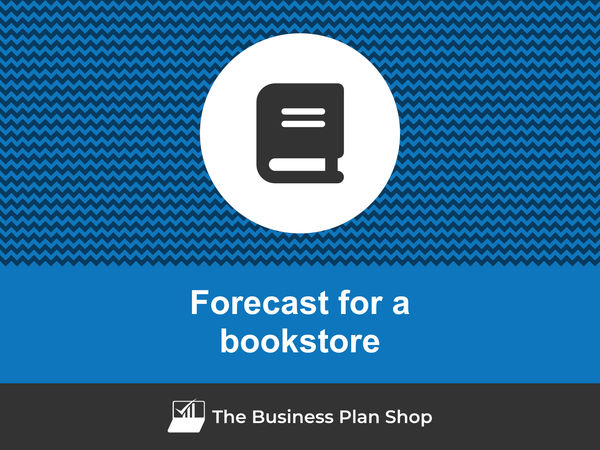
Creating a financial forecast for your bookstore, and ensuring it stays up to date, is the only way to maintain visibility on future cash flows.
This might sound complex, but with the right guidance and tools, creating an accurate financial forecast for your bookstore is not that hard.
In this guide, we'll cover everything from the main goal of a financial projection, the data you need as input, to the tables that compose it, and the tools that can help you build a forecast efficiently.
Without further ado, let us begin!
Why create and maintain a financial forecast for a bookstore?
In order to prosper, your business needs to have visibility on what lies ahead and the right financial resources to grow. This is where having a financial forecast for your bookstore becomes handy.
Creating a bookstore financial forecast forces you to take stock of where your business stands and where you want it to go.
Once you have clarity on the destination, you will need to draw up a plan to get there and assess what it means in terms of future profitability and cash flows for your bookstore.
Having this clear plan in place will give you the confidence needed to move forward with your business’s development.
Having an up-to-date financial forecast for a bookstore is also useful if your trading environment worsens, as the forecast enables you to adjust to your new market conditions and anticipate any potential cash shortfall.
Finally, your bookstore's financial projections will also help you secure financing, as banks and investors alike will want to see accurate projections before agreeing to finance your business.
Need a solid financial forecast?
The Business Plan Shop does the maths for you. Simply enter your revenues, costs and investments. Click save and our online tool builds a three-way forecast for you instantly.

What information is used as input to build a bookstore financial forecast?
A bookstore's financial forecast is only as good as the inputs used to build it.
If you are creating (or updating) the forecast of an existing bookstore, then you mostly need your accounting information, key historical operating non-financial data, and your team’s input on what to expect for the coming years.
If you are building financial projections for a bookstore startup, you will need to have done your research and have a clear picture of your competitive environment and go-to-market strategy so that you can forecast sales accurately.
For a new venture, you will also need a precise list of the resources needed to keep the bookstore running on a day-to-day basis and a list of the equipment and expenditures required to start the business (more on that later).
Let's now take a closer look at the elements that make up your bookstore's financial forecast.
The sales forecast for a bookstore
From experience, it usually makes sense to start your bookstore's financial projection with the revenues forecast.
The inputs used to forecast your sales will include the historical trading data of your bookstore (which can be used as a starting point for existing businesses) and the data collected in your market research (which both new ventures and existing businesses need to project their sales forward).
Your bookstore's sales forecast can be broken down into two key estimates:
- The average price
- The number of monthly transactions
To assess these variables accurately, you will need to consider the following factors:
- Your bookstore's location - The location of your bookstore can greatly impact the number of monthly transactions. If you are located in a busy downtown area with high foot traffic, you may see a higher number of monthly transactions compared to a bookstore in a quieter suburban area.
- The popularity of your bookstore's niche - If your bookstore specializes in a niche genre, such as rare or antique books, this can affect your average price. Customers looking for these types of books may be willing to pay a higher price, resulting in a higher average price per transaction.
- The availability of new releases - If your bookstore is known for carrying new release books, this can drive up the number of monthly transactions. Customers may specifically visit your store to purchase the latest bestseller or to attend a book signing event.
- The demographics of your local area - The demographic makeup of your local area can also impact your average price and number of transactions. For example, if your bookstore is located in an area with a higher average income, you may see a higher average price for books compared to a store in a lower income area.
- The overall economy - The state of the economy can also affect your bookstore's sales. During a recession, customers may be more price-sensitive and opt for cheaper books, resulting in a lower average price. On the other hand, during a strong economy, customers may be more willing to spend money on books, driving up your average price.
Once you have a sales forecast in place, the next step will be to work on your overhead budget. Let’s have a look at that now.
Need inspiration for your business plan?
The Business Plan Shop has dozens of business plan templates that you can use to get a clear idea of what a complete business plan looks like.

The operating expenses for a bookstore
Once you know what level of sales you can expect, you can start budgeting the expenses required to operate your bookstore on a daily basis.
Expenses normally vary based on how much revenue you anticipate (which is why, from experience, it is always better to start your forecast with the topline projection), and where your business is based.
Operating expenses for a bookstore will include some of the following items:
- Staff costs: This includes salaries, wages, benefits, and payroll taxes for all employees working in the bookstore. You will need to budget for full-time, part-time, and seasonal staff.
- Rent: The cost of renting a physical retail space for your bookstore. This can include utilities such as electricity and water if not already included in the rent.
- Inventory: The cost of purchasing books and other merchandise to stock your shelves. This can also include shipping and handling fees for ordering and receiving inventory.
- Marketing and advertising: The cost of promoting your bookstore through various channels such as social media, print ads, and events. This can also include fees for creating marketing materials.
- Accountancy fees: The cost of hiring an accountant or bookkeeper to manage your financial records and taxes.
- Insurance: The cost of insuring your bookstore against potential risks such as theft, fire, and liability.
- Software licenses: The cost of purchasing and renewing licenses for software used in your bookstore, such as point-of-sale systems, inventory management software, and accounting software.
- Banking fees: The cost of maintaining a business bank account, including monthly maintenance fees, transaction fees, and ATM fees.
- Utilities: The cost of electricity, water, and other utilities for your bookstore.
- Maintenance and repairs: The cost of keeping your bookstore in good condition, including repairs to equipment, fixtures, and the physical space.
- Professional fees: The cost of hiring lawyers, consultants, or other professionals for specific services such as legal advice or marketing strategy.
- Office supplies: The cost of purchasing supplies such as paper, ink, and pens for your bookstore's office needs.
- Credit card processing fees: The cost of processing credit and debit card payments for purchases made in your bookstore.
- Taxes and licenses: The cost of business licenses, permits, and taxes required to operate your bookstore.
- Training and development: The cost of training and development programs for your staff to improve their skills and knowledge in the bookselling industry.
This list will need to be tailored to the specificities of your bookstore, but should offer a good starting point for your budget.
What investments are needed to start or grow a bookstore?
Your bookstore financial forecast will also need to include the capital expenditures (aka investments in plain English) and initial working capital items required for the creation or development of your business.
For a bookstore, these could include:
- Store Fixtures and Equipment: This includes items such as shelving, display cases, cash registers, and computer systems. These are essential for organizing and displaying merchandise, processing transactions, and managing inventory.
- Furniture and Decor: In order to create a welcoming and comfortable atmosphere for customers, you may need to invest in furniture such as couches, chairs, and tables, as well as decorative elements like rugs, artwork, and lighting fixtures.
- Renovations and Remodeling: Depending on the condition of your bookstore space, you may need to make renovations or remodel in order to create a functional and attractive layout. This could include things like new flooring, painting, and structural changes.
- Inventory and Supplies: While not necessarily a traditional capital expenditure, it is important to budget for the initial purchase of inventory and ongoing restocking of supplies such as books, office supplies, and cleaning materials.
- Security System: As a business owner, it is important to protect your investment and ensure the safety of your store and employees. A security system, including cameras, alarms, and locks, may be a necessary capital expenditure to provide peace of mind.
Again, this list will need to be adjusted according to the size and ambitions of your bookstore.
Need a convincing business plan?
The Business Plan Shop makes it easy to create a financial forecast to assess the potential profitability of your projects, and write a business plan that’ll wow investors.

The financing plan of your bookstore
The next step in the creation of your financial forecast for your bookstore is to think about how you might finance your business.
You will have to assess how much capital will come from shareholders (equity) and how much can be secured through banks.
Bank loans will have to be modelled so that you can separate the interest expenses from the repayments of principal, and include all this data in your forecast.
Issuing share capital and obtaining a bank loan are two of the most common ways that entrepreneurs finance their businesses.
What tables compose the financial plan for a bookstore?
Now let's have a look at the main output tables of your bookstore's financial forecast.
The projected profit & loss statement
The projected profit & loss shows how profitable your bookstore is likely to be in the years to come.
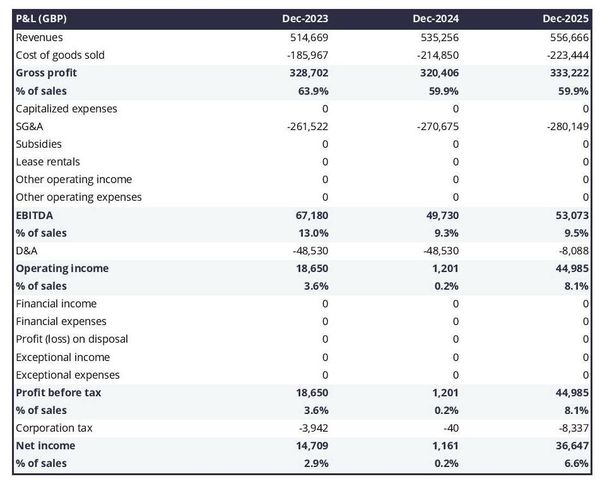
For your bookstore to be financially viable, your projected P&L should ideally show:
- Sales growing above inflation (the higher the better)
- Profit margins which are stable or expanding (the higher the better)
- A net profit at the end of each financial year (the higher the better)
This is for established bookstores, there is some leniency for startups which will have numbers that will look a bit different than existing businesses.
The projected balance sheet
Your bookstore's forecasted balance sheet enables you to assess your financial structure and working capital requirements.
It is composed of three types of elements: assets, liabilities and equity:
- Assets: represent what the business owns and uses to produce cash flows. It includes resources such as cash, equipment, and accounts receivable (money owed by clients).
- Liabilities: represent funds advanced to the business by lenders and other creditors. It includes items such as accounts payable (money owed to suppliers), taxes due and loans.
- Equity: is the combination of what has been invested by the business owners and the cumulative profits and losses generated by the business to date (which are called retained earnings). Equity is a proxy for the value of the owner's stake in the business.
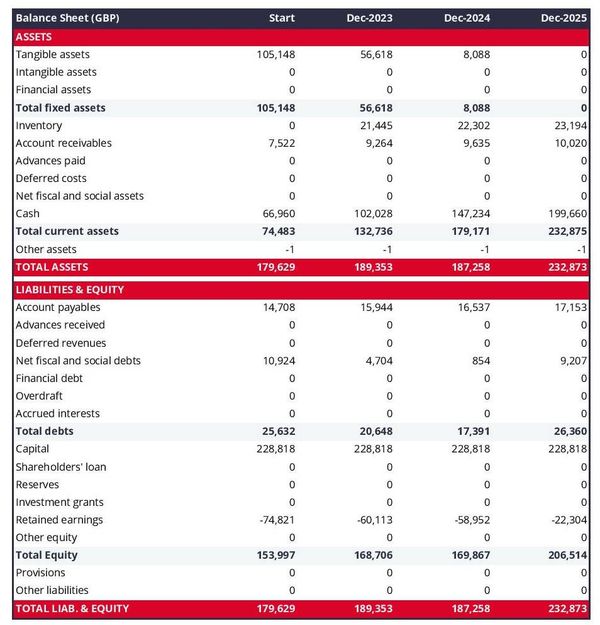
The cash flow forecast
Your bookstore's cash flow forecast shows how much cash your business is expected to consume or generate in the years to come.
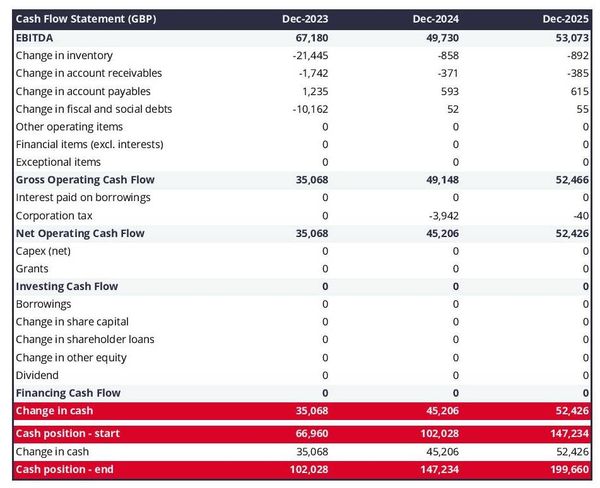
It is best practice to organise the cash flow forecast by nature to better explain where cash is used or generated by the bookstore:
- Operating cash flow: shows how much cash is generated by the operating activities
- Investing cash flow: shows how much will be invested in capital expenditure to maintain or expand the business
- Financing cash flow: shows if the business is raising new capital or repaying financiers (debt repayment, dividends)
Keeping an eye on (and regularly updating) your bookstore's cash flow forecast is key to ensuring that your business has sufficient liquidity to operate normally and to detect financing requirements as early as possible.
If you are trying to raise capital, you will normally be asked to provide a monthly cash flow forecast in your bookstore's financial plan - so that banks or investors can assess seasonal variation and ensure your business is appropriately capitalised.
Need a solid financial forecast?
The Business Plan Shop does the maths for you. Simply enter your revenues, costs and investments. Click save and our online tool builds a three-way forecast for you instantly.

Which tool should you use to create your bookstore's financial projections?
Building a bookstore financial forecast is not difficult provided that you use the right tool for the job. Let’s see what options are available below.
Using online financial forecasting software to build your bookstore's projections
The modern and easiest way is to use an online financial forecasting tool such as the one we offer at The Business Plan Shop.
There are several advantages to using specialised software:
- You can easily create your financial forecast by letting the software take care of the financial calculations for you without errors
- You have access to complete financial forecast templates
- You get a complete financial forecast ready to be sent to your bank or investors
- You can easily track your actual financial performance against your financial forecast, and recalibrate your forecast as the year goes by
- You can create scenarios to stress test your forecast's main assumptions
- You can easily update your forecast as time goes by to maintain visibility on future cash flows
- You have a friendly support team on standby to assist you when you are stuck
- It’s cost-efficient and much cheaper than using an accountant or consultant (see below)
If you are interested in this type of solution, you can try our projection software for free by signing up here.
Calling in a financial consultant or chartered accountant
Outsourcing the creation of your bookstore financial forecast is another possible solution.
This will cost more than using software as you can expect as your price will have to cover the accountant’s time, software cost, and profit margin.
Price can vary greatly based on the complexity of your business. For a small business, from experience, a simple three-year financial forecast (including a balance sheet, income statement, and cash flow statement) will start at around £700 or $1,000.
Bear in mind that this is for forecasts produced at a single point in time, updating or tracking your forecast against actuals will cost extra.
If you decide to outsource your forecasting:
- Make sure the professional has direct experience in your industry and is able to challenge your assumptions constructively.
- Steer away from consultants using sectorial ratios to build their client’s financial forecasts (these projections are worthless for a small business).
Why not use a spreadsheet such as Excel or Google Sheets to build your bookstore's financial forecast?
Creating an accurate and error-free bookstore financial forecast with a spreadsheet is very technical and requires a deep knowledge of accounting and an understanding of financial modelling.
Very few business owners are financially savvy enough to be able to build a forecast themselves on Excel without making mistakes.
Lenders and investors know this, which is why forecasts created on Excel by the business owner are often frowned upon.
Having numbers one can trust is key when it comes to financial forecasting and to that end using software is much safer.
Using financial forecasting software is also faster than using a spreadsheet, and, with the rise of artificial intelligence, software is also becoming smarter at helping us analyse the numbers to make smarter decisions.
Finally, like everything with spreadsheets, tracking actuals vs. forecasts and keeping your projections up to date as the year progresses is manual, tedious, and error-prone. Whereas financial projection software like The Business Plan Shop is built for this.
Need a convincing business plan?
The Business Plan Shop makes it easy to create a financial forecast to assess the potential profitability of your projects, and write a business plan that’ll wow investors.

Use our financial projection templates for inspiration
The Business Plan Shop has dozens of financial forecasting templates available.
Our examples contain both the financial forecast, and a written business plan which presents, in detail, the company, the team, the strategy, and the medium-term objectives.
Whether you are just starting out or already have your own bookstore, looking at our template is always a good way to get ideas on how to model financial items and what to write when creating a business plan to secure funding.
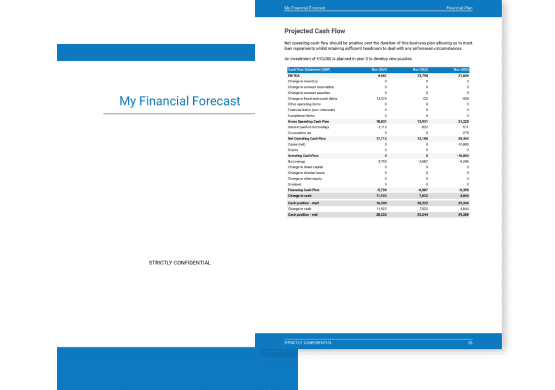
Takeaways
- Having a financial forecast enables you to visualise the expected growth, profitability, and cash generation for your business over the next three to five years.
- Tracking actuals vs. forecast and keeping your financial projections up-to-date is the only way to get a view on what your bookstore future cash flows may look like.
- Using financial forecasting software is the mordern and easy way to create and maintain your forecasts.
This is the end of our guide on how to build the financial forecast for a bookstore, we hope you found it useful. Don't hesitate to contact us if you want to share your feedback or have any questions.
Need inspiration for your business plan?
The Business Plan Shop has dozens of business plan templates that you can use to get a clear idea of what a complete business plan looks like.

Also on The Business Plan Shop
Know someone who owns or is thinking of starting a bookstore? Share our forecasting guide with them!




